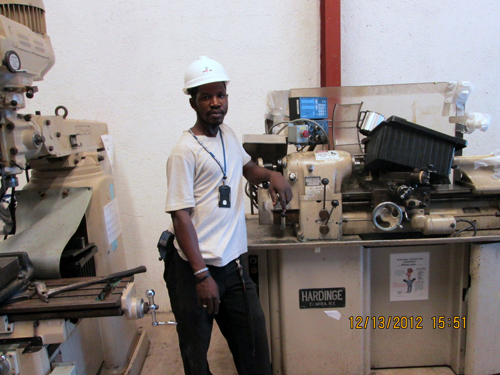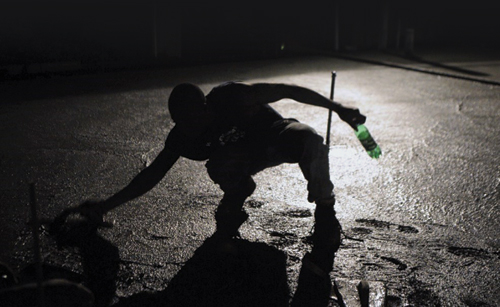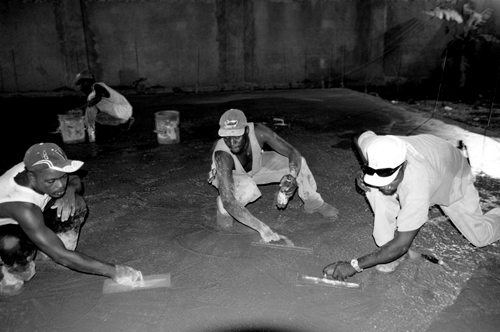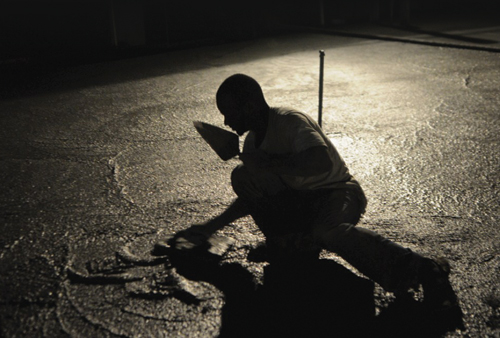 By Tim Traynor
By Tim Traynor
Director of HSC Facilities
I am beginning my sixth year of service in Haiti, working in the shadows of neglect and apathy. From the beginning, I wanted to create solid infrastructure and worthy facilities from which the thousands of international volunteers and local Haitian staff can perform their enduring miracles and petite triumphs against a daily onslaught of disease and suffering. Milot is a busy market town tenanted with goats, chickens, and pigs darting about unpaved streets avoiding parcel laden motor scooters spewing noxious blue smoke and urgent clattering’s. The human inhabitants are just as animated but more purposeful in their efforts.
A man with a broad smile and thick, leathery skin approaches me to inquire of my need for ice. I am amused at the thought that I somehow look in need of this luxury, or more likely, that I have the means with which to purchase it. A young girl dressed in a crisp blue and white school uniform, meticulously polished black leather shoes and two very large yellow ribbons woven into her ebony hair greets me with her white teeth and a perfectly inflected, “Good morning, teacher!”, an obvious phrase referenced from her English class. Other girls giggle as I return the compliment with my “Bon jour, mademoiselle!” I am aware of my alien status at moments like this one and why I can never “just blend in”. My skin is too white and my family of origin has no connection to this wonderful society other than through compassion and hope.
 I feel a large, stout hand on my back and turn to see my friend, Peapop, standing behind me with a grave look on his face. This Jamie Fox’s Django look alike is one of those remarkable men who sees only the positive aspects of attempting an impossible challenge; a task that is so uncertain in its resolve it is understood that any consequence short of complete failure is acceptable.
I feel a large, stout hand on my back and turn to see my friend, Peapop, standing behind me with a grave look on his face. This Jamie Fox’s Django look alike is one of those remarkable men who sees only the positive aspects of attempting an impossible challenge; a task that is so uncertain in its resolve it is understood that any consequence short of complete failure is acceptable.
“Boss, we got a big problem. You need to come quickly and we talk about it.”
Although I appreciate his confidence in me, there have been many times over the years that I have had absolutely no clue how to handle “a big problem” in Haiti. I have watched helplessly as heavy rains cascaded down the blue mountain escarpments that loom above the village, torrenting their way down sudden rivers into the various compounds that make up Sacré Couer, flooding all in its path. I have witnessed winds so forceful that they peeled the tin-styled roofs off their mounts like a plastic bag whirling from a passing train. And even when cholera snuck up on an already desperate population just coming to grips with the final tremors of the titanic earthquake that came swiftly upon them and without mercy, I watched helplessly as hundreds died; all events that presented very challenging and “big problems”, none of which provided any inkling of an initial resolve.
 And now my faithful friend Peapop, was informing me that yet another issue needed attention. My 65 years of seeking answers to inimitable questions leads me to approach every new dilemma with considerable reservation and then add a significant degree of difficulty when searching for solutions in Haiti.
And now my faithful friend Peapop, was informing me that yet another issue needed attention. My 65 years of seeking answers to inimitable questions leads me to approach every new dilemma with considerable reservation and then add a significant degree of difficulty when searching for solutions in Haiti.
“There’s gonna be rain tonight!” At first glance, this does not seem to be such a big deal, certainly nothing like those previously described, unless someone named Noah is involved. But the matter is an issue because we are pouring concrete for the new children’s center and rain, if heavy, will ruin the top coat of cement and perhaps the entire slab. Money is always an issue for these projects and the thought of losing a slab to the rain is an appalling thing to dwell upon for both of us. It takes but an instant to begin my inventory of what we have to mitigate the problem.
Most of the tarps we used three years ago during the earthquake recovery were in shambles, the chances of setting up any temporary shelter from the thread worn tents would take too long and our power trowel that could keep working the 2,500 square foot concrete slab needs a new gasket. Our only hope would be if the rain was light and the Haitian crew would be willing to stay late into the night and early morning smoothing out the small craters made by the impact of scores of raindrops.
This was one of those times when you understand that you are a little boat in a big ocean and you will have to do your best to stay afloat. The rains came and splattered our cement all over the crew who worked tirelessly to save it. The down pour was heavier than expected and small streams of milky white water sought their own course to the edge of the slab and into the ground below. By two in the morning the rain had stopped. There were clefts and fissures abounding over the cement surface. The men continued to coax the surface water off and reshape the slab. Finally as the early half-light of dawn crept into our long night, we determined that although far from perfect, the surface would adequately support the little legs that would trample across it once the building was complete.
Peopop’s only retort as he packed up the tools and signed the men out was, “We can fix it Boss. We will grind it down and make it smooth again!” I thought to myself, this is Haiti, a land of “we can make it work, if we keep faith and just don’t quit trying.”
 In view of the big picture, we are making strident progress, albeit a little too slow for some of us. Some of the steps are missteps and others are right where they belong. There are many more victories against the status quo than failures. In the past years, I have seen great personal growth in so many of my Haitian brothers and sisters who work at and for the hospital; individuals who have pledged themselves to build a better healthcare system and a life worth living for their families, friends and neighbors and those who come to our door in need.
In view of the big picture, we are making strident progress, albeit a little too slow for some of us. Some of the steps are missteps and others are right where they belong. There are many more victories against the status quo than failures. In the past years, I have seen great personal growth in so many of my Haitian brothers and sisters who work at and for the hospital; individuals who have pledged themselves to build a better healthcare system and a life worth living for their families, friends and neighbors and those who come to our door in need.
I have witnessed the iron commitment of a wonderful new organization in Holy Name Medical Center that speaks to the core needs of structure, education, sustainability and the positive reinforcement of a rapidly developing Haitian staff. I have felt the strong support from our medical and non-medical volunteers, both newly acquainted and those who have been making trips to Milot for more than twenty years, as they have recommitted themselves to this extraordinary “idea in the jungle”.
Like Peopop said, “We can fix it Boss.” His mantra is now mine. I am proud to have spent my time doing something worthwhile for these generous and appreciative people. It may be the greatest gift any of us can get which is to help other human beings realize the power and effect that a determined people can have over insurmountable odds in an unyielding environment. It has been my experience that when given the opportunity and tools needed to succeed, most Haitians will give their all to accomplish this destiny. Forget all that negative talk about the failed governments, broken promises, apathy and greed. I have said this many times before, “In Haiti, for thirty years and especially today, Hôpital Sacré Coeur works!”
Tim Traynor serves as Director of HSC Facilities for the CRUDEM Foundation. He splits his time between Milot and his home on Kiawah Island, South Carolina.









